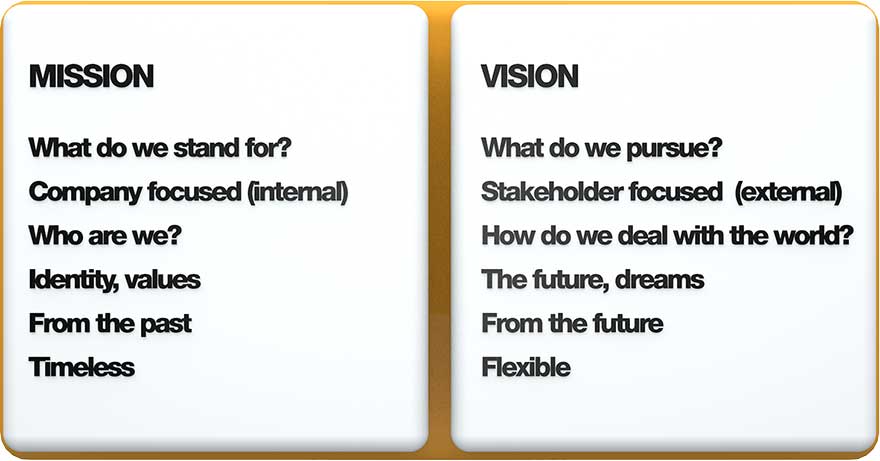تفاوت چشم انداز و ماموریت

Vision and are often developed and used together for the same purpose. This confuses many people into thinking that vision and mission could be used interchangeably, when actually they can’t.
| Vision | Mission |
|---|---|
| Purpose | |
| Tells what an organization aims to achieve. | States what a company is currently doing. |
| Answers the question | |
| What do we want to become? | What do we do? |
| Includes | |
|
|
| Future or present time? | |
| Talks about the future | Talks about the present |
| To whom it is developed? | |
| Employees of the company | Employees, customers, suppliers, distributors, partners and communities |
| Which one is created first? | |
| Developed first | Developed only when vision is available |
| How often does it change? | |
| Rarely changes because it takes years to achieve most of the objectives | Product-oriented missions change every time when a company decides to venture into a new product market. |
There are clear differences between the two statements that should not be neglected.
Benefits
Not all the visions are equally good. Some of them are very generic or focus on financial objectives and as a result, poorly motivates employees. But if a company puts enough efforts in creating vision statement, it results into following benefits:
- Motivates and inspires employees
- Provides one purpose to work for
- Sets the stretch goals (goals that are impossible to achieve with current resources and capabilities)
- Guides managers in effectively allocating resources
Writing the statement
Creating a vision is an important first step in strategic management process. We identified these steps and guidelines to help you write an effective statement.
Step 1. Gather a team of managers, employees and shareholders. Vision is the statement that must be understood by employees of all levels. As many people as possible should be involved in the process because involvement leads to stronger commitment to company’s vision. After choosing the people that will be involved you should also distribute several articles to them about what is organization’s vision and ask everyone to read them as a background.
Step 2. Ask everyone to write their own version of vision. The next step is to ask everyone to write his or her own version of the statement and submit it to the responsible team. After receiving the statements, the team should try to combine draft vision out of all the submissions. This is also a great opportunity to resolve any conflicting views about firm’s ultimate objective.
Step 3. Revise the statement and present the final version. The draft statement should be distributed to the members again for their last revision. Upon receiving the feedback, the final version of the vision should be created and presented to every employee.
Don’t forget that a vision should be a one sentence clear, inspirational and memorable statement.
Vision statement examples
The best way to learn creating a vision is to look at the currently available good and bad examples.
| Chevron: To be the global energy company most admired for its people, partnership and performance. |
| Feeding America: A hunger-free America |
| Habitat for Humanity: A world where everyone has a decent place to live. |
| Microsoft: A computer on every desk and in every home |
| Save the Children: Our vision is a world in which every child attains the right to survival, protection, development and participation. |
| General Motors: To design, build and sell the world’s best vehicles. (Best in what? GM should have specified their objective) |
| Ikea: At Ikea our vision is to create a better everyday life for the many people. (This is impossible to achieve) |
| Samsung: Inspire the World, Create the Future. (The statement is too vague and doesn’t set any objectives) |
| Toyota: Toyota will lead the way to the future of mobility, enriching lives around the world with the safest and most responsible ways of moving people. Through our commitment to quality, constant innovation and respect for the planet, we aim to exceed expectations and be rewarded with a smile. We will meet our challenging goals by engaging the talent and passion of people, who believe there is always a better way. (It is too long and sounds more like a mission than a true vision) |


